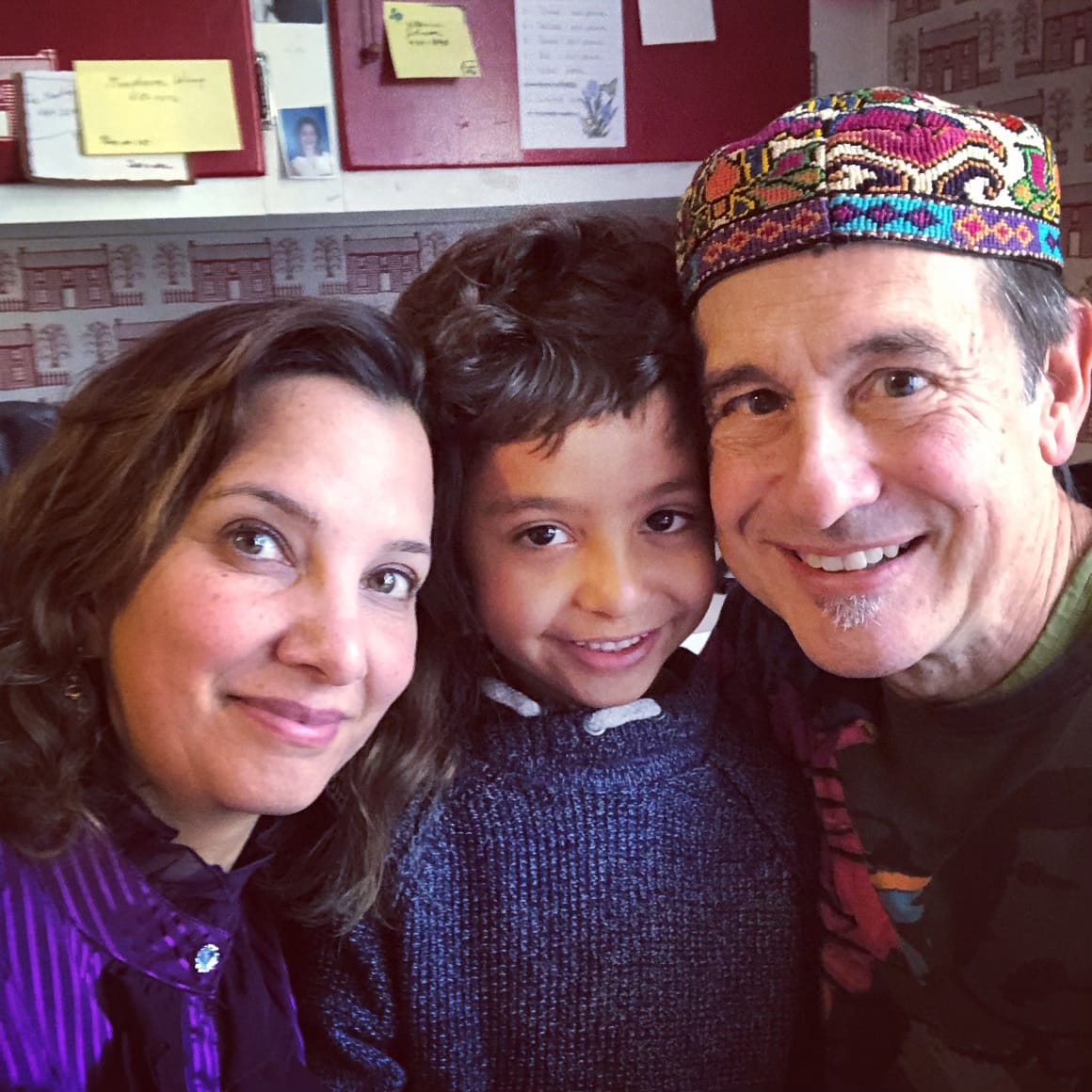
By Michael Russo, contributor
A friend. A clown. A healer. A husband. A father. A playwright.
Both literally and figuratively, Dr. John T. Glick wore several hats. For many years, he served the Elkton-Shenandoah area as a doctor, and his loved ones say he could take care of anyone and anything. He was the kind of doctor who wouldn’t just send you home with a prescription. He’d listen to his patients’ stories and ask questions. When Glick became the first acupuncturist in the Shenandoah Valley, long sessions with clients often meant he provided psychotherapy along with pain relief.
Glick extended his healing abilities beyond the traditional sense of treating illness.
With his play, “Can’t Feel at Home,” he has told the story of the families displaced as the Shenandoah National Park and Skyline Drive were built in the 1930s. Personal experiences of his patients or their family members from that era formed the backbone of the plot.
“Can’t Feel at Home” returns for its third time at Court Square running from Aug. 31 through Sept. 10 with 10 performances, four of which are weekend matinees.
This follows two runs of five sold-out shows each in both December 2022, when the play premiered, and in January. The shows not only capture a crucial period of turmoil in this region but also represent the legacy Glick leaves after his death in January.
Tickets are still available and cost $25 in advance or $30 at the door. This latest run not only provides an opportunity for those who haven’t seen the show, J.P. Gulla, director of Court Square Theater, said, but also for those who want to see it again. It will be a “much more beautiful” experience, he said, because upgrades to the theater’s lighting system will enhance the production overall and aid in illustrating the play’s shifts in time, for example.
Glick conceived the play as a way to help heal those affected by the conflict and create an opening to discuss an era that isn’t often talked about openly, said Stanley Swartz, the play’s director.
The production fully came to life in 2022 through the work of Swartz, who adapted Glick’s original screenplay into a script fit for the stage. In addition, Robert “Bobby” Wolfe and Joe Appleton — Glick’s longtime friends and the play’s co-producers — as well as Gulla, helped make it all happen.
Swartz said it was clear that Glick loved the characters, the people they’re inspired by and the chance to tell their stories.
“The fairness aspect, and showing multiple sides to the story, is part of the healing thing, because we see characters from both sides caught and both sides are being forced to do things that they don’t necessarily want to do,” Swartz said. “People knew that [John] was not trying to condemn them or judge them or anything else. It was obvious that people knew that he was wanting the best for them however that could come to them.”
And the way Glick cared for and shared the experiences of others shines through from his own life story, say those who knew him best.
Full moon fever
It’s October 1974. And John Glick’s job for the night’s Halloween party is to take care of the music and keep it going with upbeat hits like “Hooked on a Feeling” or tunes from Elton John or Barry White.
Among those arriving at the party is a butthead — not someone being a jerk but a literal butthead: a guy with anatomically correct, paper-mache buttocks on his head. The butt follows Glick around all night, watching where he goes and what he does through the only spot where light could get through: the butthole. Two hours pass before the man beneath the cheeks removes his fleshy helm and reveals himself to Glick.
“Hi, I’m Patch. How are you?”
“Hi, I’m John.”
The friendship between Glick and Patch Adams — the real-life inspiration for the film “Patch Adams” starring Robin Williams — was born that night and lasted a lifetime. The two would go from that small Halloween party to traveling the world together … as clowns.
Born in Richmond, Glick moves to Harrisonburg to start his junior year at Harrisonburg High School. While there for just two years, he makes friends easily and even becomes class president. After graduating, Glick attends the College of William & Mary and, later, the Medical College of Virginia — now Virginia Commonwealth University (VCU) — where he earns his medical degree and meets Patch.
Patch Adams’ dream was to create a free hospital in West Virginia with laughter and love as the basis for healing — and clowning as the primary prescription. This idea serves as the foundation of the 1998 film, and while it doesn’t lead to the hospital’s construction like Adams hopes, it opens doors for hospital clowns across the globe and inspires them to follow in Adams’ big, floppy footsteps.
So, as Adams starts the Gesundheit! Institute and begins to travel the world as a clown, his friend John Glick joins him when he wasn’t practicing medicine back in Elkton and Shenandoah. Adams, who’s big and loud and sometimes intimidating, remains the heart of Gesundheit. Glick, with more of a toned-down demeanor and soft look in his eye, was its soul, and that informed his approach to clowning in more than 30 countries.
… With love
In Russia, Glick and his fellow clowns are in the city, maybe Moscow, when soldiers approach and block them. Dark military uniforms stand opposite the colorful outfits and bright red noses. Glick removes his nose and gently places it in a soldier’s hand. Other clowns follow his lead. The clowns start singing together, and while the soldiers might not understand all the words, they dance along with John and his peers.
At San Quentin State Prison in San Francisco, Glick and the Gesundheit! clowns visit the facility’s exercise yard. Outside, there’s a mix of inmates — White, Latino, Black — but each group of prisoners keep to themselves in their own corners of the space. Glick and the other clowns play songs like “Green Acres” and “La Bamba” as the inmates heckle them in the background. But just like in Russia, Glick and the clowns persist. Through music, singing and dancing, the prisoners, once isolated in their own bubbles, unite. As Glick leaves, the deputy warden, who’s been at the prison for 20 years, tells him he’s never seen the groups mingle like that, but the clowns made it happen.
On another trip, Glick visits a refugee camp in Macedonia. About 12 to 15 clowns join him, and every day for five days, they play. By the last day, one of the camp leaders talks to Glick about the clowns — of all the resources that could’ve been sent to the camp — and says something along the lines of:
When I first saw that those clowns were coming, I thought to myself, ‘Why did they send all these clowns — fucking clowns? My people need this and that. My people have seen so much sorrow, so much trauma. They send clowns — what the hell?’ And now I understand. Look at my people. This morning, I woke up to the laughter of children. I have not heard that in many, many months. And that’s when I understood why clowns were sent to my camp, and I’m very grateful.
In Lima, Peru, Glick meets another clown, and her name’s Nanny Durand. It’s 2003, and Nanny’s hospital clown organization invites the world famous Patch Adams to visit for speaking engagements. So, Adams travels to Lima with John Glick and Glick’s daughter, Terra, as well as three other clowns.
Clowning can be anything, but Nanny defines it as the art of play. It could be starting a party or praying with someone in need. It’s being the best form of yourself so you can meet someone at their level and support them how they need it most. These clowns don’t paint their faces or have rehearsed skits. It’s improvisational, and Nanny and John had chemistry.
After the initial visit, John returns to Peru and sees Nanny once or twice a year. Each time they separate, their friendship is paused. When they reunite, it’s like hitting play without missing a beat. With such ease, John and Nanny’s friendship blossoms into something more.
“There was a lot of no, no, no, no,” Nanny says. “But then the universe said, ‘Yes, yes, yes, yes.’ There was nothing we could do.”
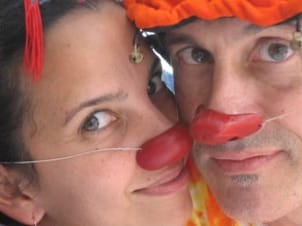
Nanny was born almost 3,500 miles away two months after John met Patch on Halloween night 1974. Because of John and Patch’s friendship, John and Nanny met and fell in love. As she describes it, before she was even born, the threads of destiny were being written. So, the universe did say yes. And while a relationship between two clowns with a 22-year age difference can spark questions, Nanny says their souls were tuning to each other. She and John spent years getting to know each other over Skype, “building a bridge without even kissing” and talking about marriage and kids before they ever shared any physical attraction. When they reunited once more in 2006, it was a moment pulled straight from the movies.
“We did one of those scenes, very embarrassing scenes, for other people in the airport where they run to each other, and they kiss. People are like, come on, get a room,” she says. “We were one of those … and it was wonderful.”
‘Really good years’
Nanny and John marry in Elkton in a small, intimate ceremony at the Kite House with family and friends, most of whom are John’s, on Dec. 2, 2007, which is also Nanny’s parents’ anniversary. They’re the last couple to wed at the Kite House, before the historic site, which was Stonewall Jackson’s headquarters before and during the Civil War, becomes a full-time museum. Having only moved to the U.S. two months prior, Nanny says she wasn’t yet accustomed to some of the culture and traditions of America, but it was a priority to begin Nanny’s green card process.
Two months later, John and Nanny hold another ceremony in Lima, Peru — in a Catholic church full of clowns. Red noses, funky hats and headbands and vibrant, colorful outfits fill the venue while John and Nanny have their first dance to “The Blue Danube.” Such a buoyant, at-times comedic, piece is appropriate for the couple — they met clowning after all — as the rest of the crowd joins the waltz and shares in the joyful energy for hours.
“I have gone to weddings here [in the States]. There’s some dancing and there’s an emcee, and it’s usually indoors — or well, not only indoors — but there is an emcee and well, in Peru, it’s different,” Nanny says. “There is dancing, yes. There is always dancing and there is a lot of partying and you party till four in the morning. It’s very different. Very, very different. So, it was pretty wild and fun and loving.”
Steep ups and downs would follow. A year after the couple’s wedding in 2009, John learns he has Parkinson’s disease.
The pair then welcome their son Mateo in 2011, while John continues practicing medicine, playing music, cracking jokes, finishing other people’s sentences and clowning with Nanny — and even Mateo on a few trips.
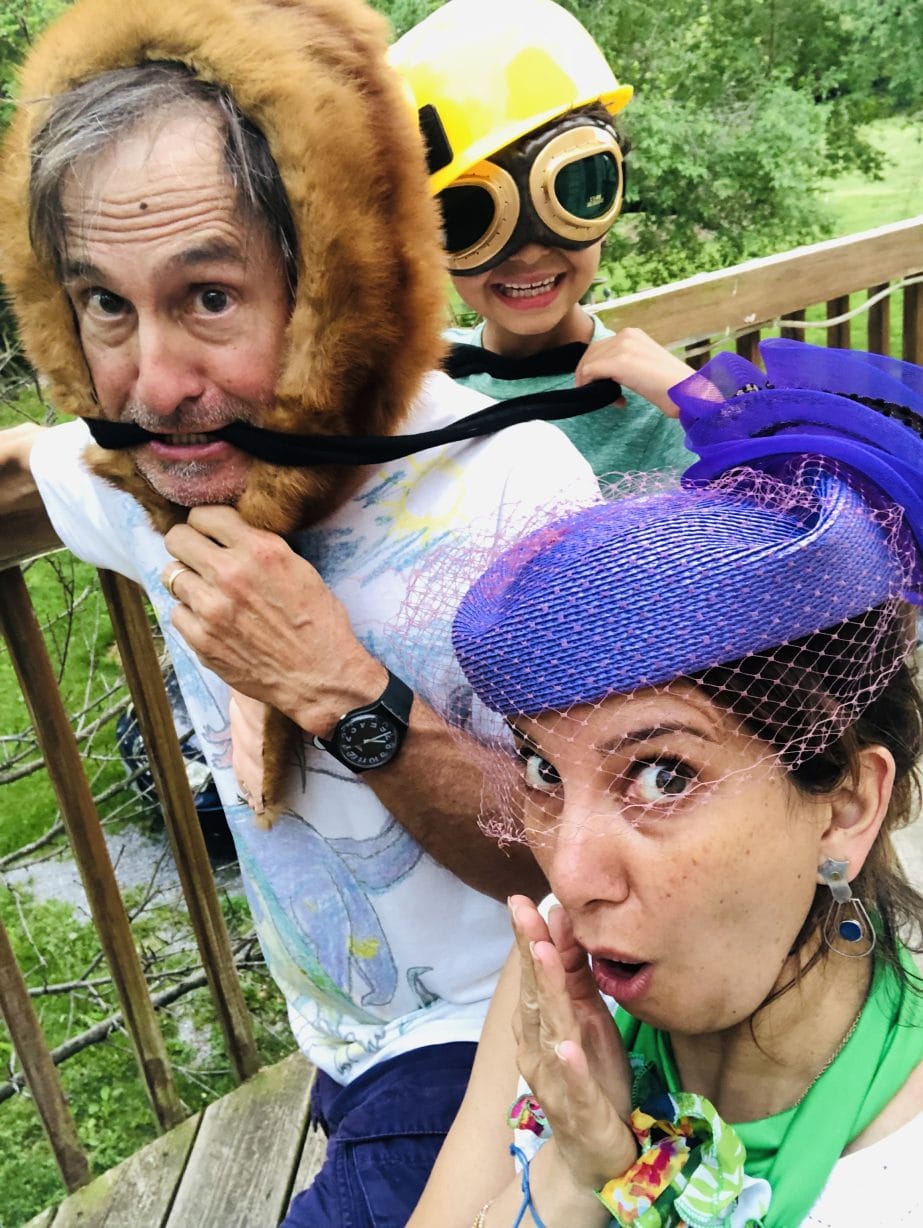
While the goofiness of a clown and professionalism expected of a doctor might seem like a contradiction, John represents the epitome of both. As Nanny puts it, doctors treat someone’s illness. Clowns play and connect with the healthy part of a patient. Doctors ask questions like, “How are you feeling? Are you okay?” Clowns say, “Hey! Hi! How’s your day? What are you up to?” For John, being a clown and doctor went hand in hand, Nanny says. John would say, “Tell me.” He’d listen. Then he’d say, “Tell me more.”
When not off clowning, John spreads his roots in Elkton, where he had started a family medicine practice with his medical school friend, Steve Phillips. That friendship turned into brotherhood as Phillips married John’s sister, Debbie.
The two men perform as the duo Glick & Phillips, singing cover songs and originals and joking about all sorts of topics, like the abundance of Shiffletts in Elkton or the latest news.
Despite John’s Parkinson’s diagnosis, John and Nanny have “really good years,” she says.
But the disease was changing his life. When John’s condition worsened to the point where he couldn’t play music anymore, Phillips said it “crushed his spirit.”
For John, he didn’t play music just to play; the experience brought him new friends and yet another way to help them feel better. So, perhaps John’s ability to combine his talents as a clown, physician and musician was one of the key factors that made the people he healed trust him enough to share their stories with him.
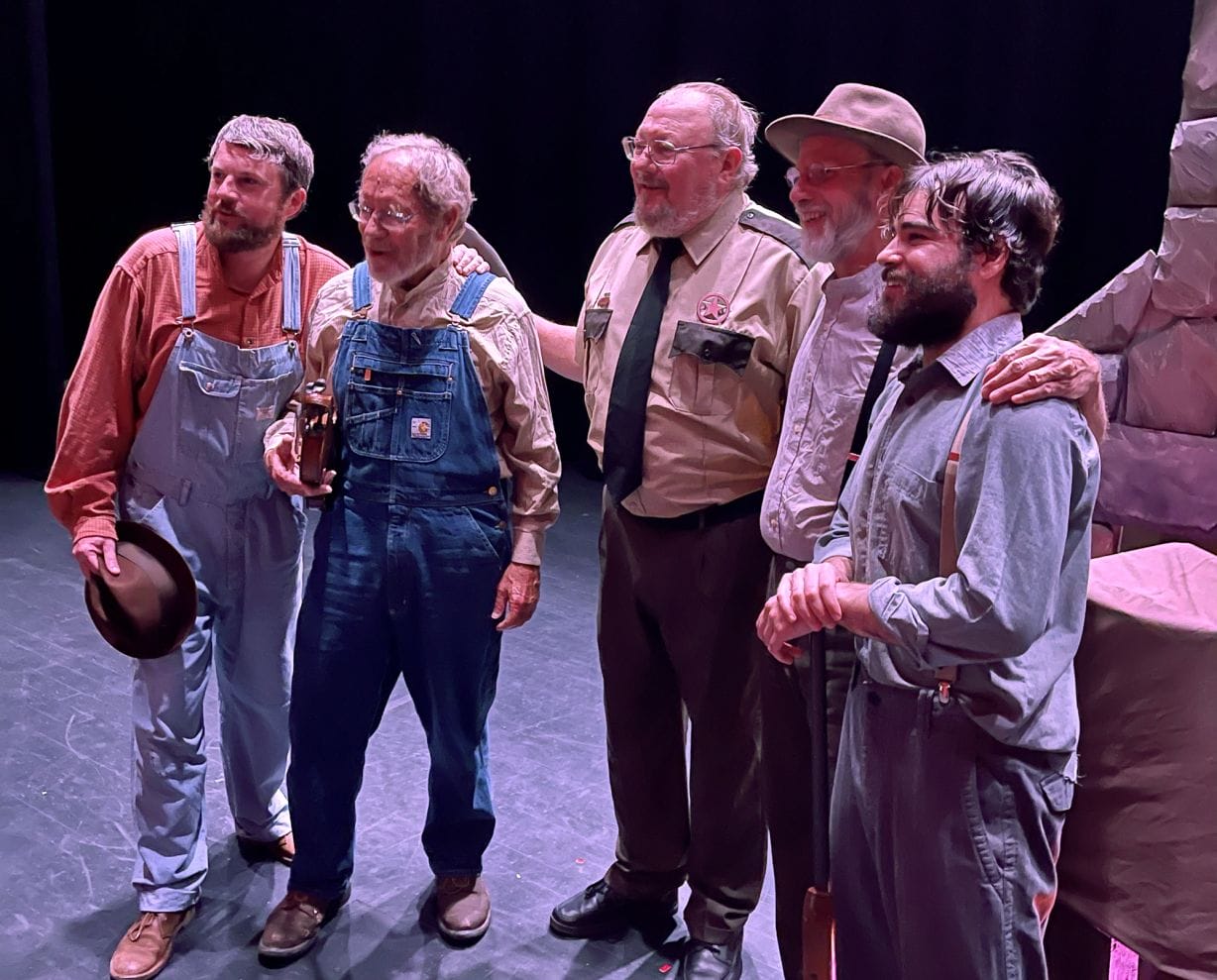
‘A labor of love’
Robert “Bobby” Wolfe, John’s longtime friend, played a big part in the final years of John’s life. John and Bobby were classmates at Harrisonburg High School and went their separate ways after graduation in 1970, but they reconnected when Wolfe retired in Harrisonburg five years ago. At the time, Wolfe didn’t know John had Parkinson’s, but he used his family experience to help John through his condition. The pair would often have long walks together and take trips to the Blue Elk Coffee Shop.
One day while Wolfe and John walked along the golf course at Massanutten Resort, they saw a man coming out of the lodge and restaurant. He was using crutches to compensate for an amputated leg. Wolfe was ready to carry on with a gentle smile or a wave, but John asked the man, “How’d you lose your leg?” Embarrassed by the question, Wolfe braced himself, thinking the man might swing a crutch at John for being so blunt. But that didn’t happen. Instead, John’s question led to a 30-minute conversation with the man, who told of his military service.
On another occasion on March 15, 2022, Wolfe arrived to pick up John and take him to the gym like any other day — but it wasn’t. John told Wolfe he had something for him and went upstairs to find it. John returned empty handed and asked Wolfe what he had gone upstairs to do, so Wolfe reminded him. John disappeared up the stairs again and returned this time with a gray notebook containing the script for a play called “Can’t Feel at Home” — a collection of stories John’s patients told him about their families being displaced from the Blue Ridge Mountains as Shenandoah National Park and Skyline Drive were developed.
“See what you can do with it,” John told Wolfe.
Wolfe said he reads through works by flipping to every tenth page. If he likes what he sees, he’ll go back and read through the rest. And that’s what he did with “Can’t Feel at Home.”
“We got something here,” Wolfe said.
John envisioned it as “a healing play for the community,” but Wolfe first saw it as primarily a historical work about the displacement of people who lived in the Blue Ridge Mountains as the Shenandoah National Park and Skyline Drive were built.
As “Can’t Feel at Home” developed, it became both. John originally completed the play in 1998 and wanted it produced in a festival with shows in Elkton that would combine humor, music and readings. Wolfe enlisted Joe Appleton, a friend from Harrisonburg High School who had theatrical experience, to join him as a co-producer. Together, they shopped the play around.
Originally more of a screenplay running three-and-a-half hours and containing 40 songs, director Stanley Swartz cut it down to a two-hour show for the stage — a major feat, Swartz said, but a rewarding one.
“It’s been very uplifting. It keeps me going through all the hours and the hard work and stuff, though, just that it is doing so much positive,” Swartz said. “It makes me very excited to be a part of the whole project.”
While people told the producers they loved John and his script, no one wanted to tackle the production at first. After much rejection, Wolfe and Appleton found the “yes” they needed from J.P. Gulla and brought “Can’t Feel at Home” to Court Square Theater in downtown Harrisonburg.
Gulla, after getting to know John better, came to find just how many lives he had touched in the community, and that it wasn’t limited to his former patients, clients and friends.
“The most powerful thing on my end was understanding and realizing how he impacted so many people’s lives, and how many so many people knew him and knew of him and were influenced by him,” Gulla said. “I’m like, ‘Oh my gosh, who knew?’ I didn’t know this stuff, that this man had impacted so many people’s lives for good. It was just like, ‘Wow.’ So for me, outside of the story, that was a really beautiful realization in the journey, and still is.”
While Wolfe, Appleton, Swartz, Gulla and the rest of the crew and cast brought the play to life, John experienced more setbacks with Parkinson’s. His symptoms, which began as a twitch in his legs or hands, became more severe tremors over the years, and John developed cognitive issues, including dementia, which grew to be more prevalent at the start of the COVID-19 pandemic.
John would leave toothpaste in the refrigerator instead of the bathroom sink, or he’d wander around the house. Over Memorial Day weekend in 2022, he fell and broke two ribs. His dementia led to some paranoia, and during an episode in August, he fell again and broke his hip. Nanny didn’t want Mateo to see his dad in this kind of pain or state of mind, so John moved into a memory care unit at The Phoenix in Harrisonburg. There, he had yet another fall and injury in October, and it was clear he wouldn’t be able to attend the opening night of “Can’t Feel at Home” on Dec. 1 — the day before his and Nanny’s 15th wedding anniversary.
Ten sold-out shows at Court Square led to another 10 slated for August and September. But before John died, Wolfe arranged for some of the show’s cast to perform a few scenes live at The Phoenix for John and the other patients. John also watched a full recording of the show. For many of the performers, it was the first time they met John, and the support was overwhelming for Nanny.
“I was very accustomed to have people saying, ‘John, you changed my life. You saved my life. Your friendship. You.’ I’ve heard that many times right away, many, many times,” Nanny says. “But it was amazing to me to hear that from people [who] were just meeting him, or people who met him through the script, or … people that were meeting him like that, off, like it was not him. And it was like, ‘Oh, you don’t know what you are missing, or what you missed.’”
John Glick died Jan. 17, but “Can’t Feel at Home” has introduced his spirit to wider audiences.
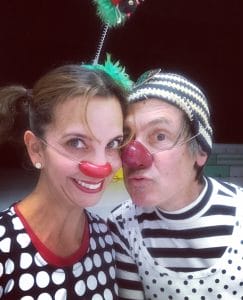
Swartz said audiences have also empathized with the themes of “Can’t Feel at Home,” and some have found comfort in learning part of their family’s story that Swartz said was often suppressed or left unspoken.
“We’ve had lots and lots of people in tears telling us, ‘My grandmother was one of the people,’ or that type of story about relatives, and just thanking us for doing the play and how healing it was to have it talked about,” Swartz said. “So for these people to now get the story and understand what their parents or grandparents went through, it kind of makes things make sense for them. And because it’s being talked about, the healing can flow.”
Gulla said the play’s heavy focus on the region allows people from the community to connect with jokes geared toward the Valley or language that people native to the area might use.
“John’s brilliance in writing his lines with the family names that are involved — those particular punch lines, and those particular puns and those particular suggestions in the verbiage of what he puts in there, only families that know those names would really connect to that,” Gulla said. “Whether they’re … mentioning the name Shifflett or they’re a Hensley, we always get a laugh for many of those lines, because people get it.”
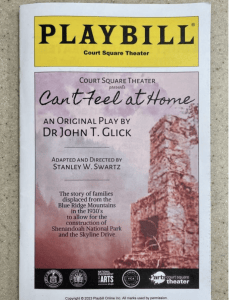
Now, Wolfe and Appleton are creating more opportunities for people to experience “Can’t Feel at Home” and continue John’s legacy. It’s a way to honor what they call the best friendship ever. Closer to John’s original vision for the play, the Elkton Community Center hosted showings of the production in April with clips from a performance in Court Square accompanied by live music from John’s former performing partner Steve Phillips and Q&A opportunities.
The producers plan to continue sharing the show in the eight counties that make up the Shenandoah National Park, just like John intended. They held three full-production performances in Charlottesville over the summer. Nanny calls these events an “homenaje,” or a tribute, dedicated to John as much as it is to the play’s story. Each one is like another memorial, another celebration of his life, and the intimate nature of it brings everyone there closer together.
“I see people grieving right and left for John’s death. And it’s interesting to me,” Nanny says. “It happens to me a lot that I’m giving people hugs and consoling people, you know? It’s interesting how me, the widow, is the one saying, ‘Hey, oh, I know. I’m sorry for your loss. Oh, yeah.’ Right and left, up and down. People that say, ‘You might not know me. You don’t know me, but John and I used to be good friends.’ Or ‘You don’t know me, but John was my doctor.’ People get really, really sad.”
Such grief indicates a profound impact, and now the person who would’ve healed that sorrow in the community isn’t here to do so. But nevertheless, John’s presence remains in the stories he’s told, and the stories people tell of him. Through his friends. Through his children, Terra and Mateo. And through Nanny, who will always talk about and share her love for her husband.
“It just makes me feel very, very proud of John,” Nanny says. “And whenever somebody said, ‘Hey, yeah, I met John.’ And I said, ‘Then you know what we’re talking about’ … There’s a lot of love coming after him. ‘Yeah, I met John,’ or ‘John was my doctor’ or ‘John was my friend’ or ‘I played music with John.’ Then I know that that’s how it starts, and the way it’s gonna finish is with some sort of love, some sort of love story.”

Thanks for reading The Citizen, which won the Virginia Press Association’s 2022 News Sweepstakes award as the top online news site in Virginia. We’re independent. We’re local. We pay our contributors, and the money you give goes directly to the reporting. No overhead. No printing costs. Just facts, stories and context. Thanks for your support.












